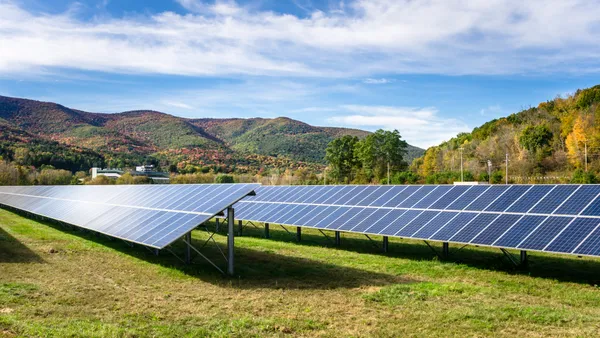Dive Brief:
- Despite pushback on ESG in the U.S. and broader macroeconomic pressures, sustainable investments — including green and sustainable bonds — are positioned for continued growth, experts said in a Wednesday webinar organized by global energy and sustainability advisory firm Trio.
- Trio, a subsidiary of Edison International, was joined by representatives from Morgan Stanley, Verizon and power management company Eaton, who highlighted how sustainable bond issuance is positioned to increase. In the first quarter of 2024, green and sustainability-linked bond issuance represented the largest level of supply in any quarter for the asset class, according to Nicholas Tatlow, a managing director at Morgan Stanley.
- "Our new thesis is that sustainable investing is absolutely around to grow for the medium and long term,” Tatlow said. He noted that though there has been pushback on ESG, Morgan Stanley’s view is this resistance has only spurred a “pretty modest impact on the overall ESG fund flows.”
Dive Insight:
Morgan Stanley, which advises clients on green and sustainable bond issuance, projected a positive outlook for the category in its 2024 ESG analysis for fixed income. While new standards and increased investor scrutiny may pull back corporate issuance, the firm expects a strong fixed income backdrop, as well as sovereign and supranational financing to boost green and sustainable supply and opportunities. Green bonds showed resilience compared to other sustainable bonds, with 2023 green issuance closing at more than $560 billion by year end.
“The fact that transparency is improving … certainly means that it’s setting up [sustainable investing] for secular growth over the next several years,” Tatlow said.
Representatives from Verizon said the company has issued six green bonds totaling $6 billion since 2019. The telecommunications provider uses green bonds in support of its virtual power purchase agreements, according to Kee Chan Sin, deputy treasurer and senior vice president of corporate finance at Verizon.
Sin said Verizon issues green bonds for three reasons: to help the company meet its emissions reduction targets; they offer a lower cost of capital; and green bond issuance helps establish the company as a “thought leader” in the market. The investments also build on Verizon’s target to achieve net-zero for scope 1 and scope two emissions by 2035. Verizon also has a near-term goal to source renewable energy equivalent to 50% of its consumption by 2025, 100% by 2030, according to Sin.
Earlier this year, the company announced it had invested all of the net proceeds of its nearly $1 billion green bond in renewable energy projects spread across five states. These renewable energy purchase agreements cover nearly 0.9 gigawatts of new renewable energy generating capacity, of which 53% is solar energy and 47% is wind energy, according to Verizon.
Meanwhile, Eaton’s science-based target initiative approved goal is a 50% reduction in greenhouse gas emissions from a 2018 baseline by 2030 along with a scope three target of 15% reduction from the same baseline by 2030, according to the company’s vice president of corporate environment, health and safety programs and sustainability, Karen Lynn.
In August 2022, the company closed a $1.3 billion sustainability-linked bond targeting scope 1 and scope 2 emissions that includes performance targets.
“We found that there was some pretty good alignment between what the bond market was interested in and the goals that we had established,” Lynn said. “It's putting your money where your mouth is.”
Eaton’s sustainability-linked bond wasn’t a fundraising effort, but a way to refinance its existing debt, and not linked to any particular project, she said.
“We're not tracking, spending on specific projects that we're using to get to our goal, but just really taking advantage of [our] reputation for sustainability, taking that to the market, and having large investors then recognize that we have a strong sustainability profile, and that they're willing to fund us in this manner.”
Green bonds are directed toward specific projects, while sustainability-linked bonds aren’t linked to a specific project. The latter is typically set up in a way that the issuer needs to meet certain key performance indicators. Green bonds are most relevant “where you've identified large capital programs,” according to Tatlow, while sustainable bonds allow issuers to align their financing and ESG strategies holistically. Green bonds typically account for 60% to 70% of issuance of bonds in the category, he said.
Positive outlook for green and sustainable bonds
Sustainable bond issuance rose to $281 billion in the first quarter of 2024, up 36% from $207 billion in the fourth quarter, representing a slight increase from the $279 billion generated from issuances the year before, according to a May report from Moody’s Investors Service. Sustainable bond volumes are on track to reach $950 billion this year, the report said.
Citing S&P Market Intelligence research, the most recent Edison Energy global renewables market update from last month projected that green bond issuance is poised to accelerate over the next two years if interest rates fall. Heightened demands for transparency on ESG initiatives will likely bolster growth for green and sustainability-linked bonds, Tatlow said.
One area of uncertainty in the market is the extent to which artificial intelligence efforts draw on power resources, Sin pointed out.
“What will the consumption of power be in the era of AI? That is the biggest unknown, and I can tell you, that number … will be extremely high,” he said, noting it could affect companies pursuing sustainability targets set long before the recent AI push.
Industry stakeholders will be monitoring the impact of AI on power consumption and how it will affect the achievement of sustainability targets, he noted.











